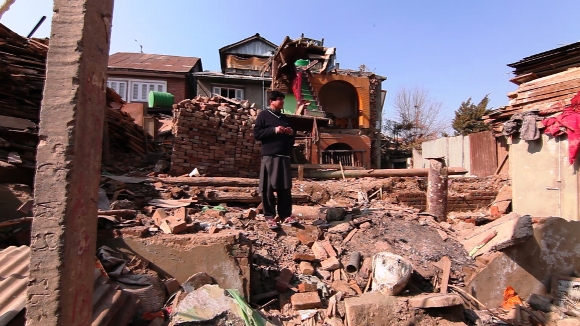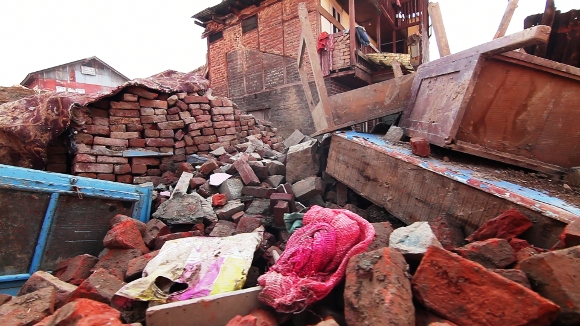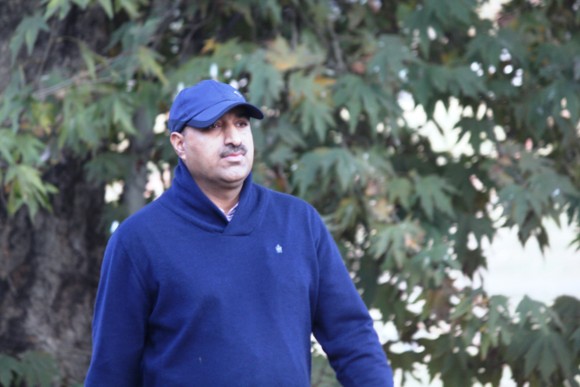“Tireless rains tore through Kashmir -- known to the world as the paradise. In September 2014, it rained, rained and rained. Clouds burst, Jhelum grew in might. The barriers of the city were knocked down. Hitherto benign and Innocent River of life had become a river of death. And,
All that was visible became invisible.
All that was apparent became in apparent,
All that was erect was submerged,
All that could be swept was swept away in a wrath.”
These are the opening lines in the voice-over of the 20-minute documentary Kashmir Flood – Let the Vale Rise directed by Bilal Jan. It is a moving documentation of the devastating floods of September 2014, when the picturesque valley of Kashmir experienced the worst ever rain fury of the past 100 years. Every aspect of human life – health, education, habitation and all else – was severely affected by the flood.

A scene from the documentary Kashmir Flood – Let the Vale Rise directed by Bilal A Jan. Pic: Bilal Jan
Bilal Jan’s brilliant film presents, through outstanding bold and telling footage, the immediate after-effects of the floods that changed almost the entire topography of the state often described as “Heaven on Earth.”
“It was an incredible and life-threatening experience for every single Kashmiri – man woman and child, of all ages and communities, and I was no exception. I am one of the survivors. The courtyard of our home in Chattabal in Srinagar was completely inundated. This was the worst experience of my life. But I did not have a professional camera to shoot the scenes and even if I had one, the total lack of electricity would have made charging the battery of my camera impossible. Even cell phones had stopped working,” says Bilal about his personal experience which eventually led him to make this film.
Kashmir Flood – Let the Vale Rise spans 20 minutes of screening time shot with an HD-5D mark II camera within a shoe-string budget. The cinematography is by Zefar Iqbal with sound by Mukhtar and editing by Jehangir Mehraj. “Most of the technical and creative crew worked as volunteers without being paid. I have dedicated the film to those who lost their lives in the flood fury,” informs Bilal.
The filmmaker and his calling
Bilal Jan is a strapping young director who honed his skills in filmmaking first at the FTII where he enrolled for their film appreciation course and subsequently, by assisting renowned filmmakers including Shyam Benegal, Vidhu Vinod Chopra and Dr. Jabbar Patel.
The director of the documentary - Bilal A Jan. Pic: Bilal Jan
His first documentary The Lost Childhood won the Nina Sugati SR Award for "Best Director" in conceptual art in cinema and a prize at the first ever J&K film festival organized by the J&K Cultural Academy for Art, Culture and Languages in 2010. It is the very first documentary in Kashmiri language to have been selected at an International Film Festival.
This was followed by two noted documentaries – Ocean of Tears and Daughters of Paradise. As a dedicated documentary filmmaker, he is totally dedicated to making films in and around his home state – Kashmir.
Kashmir Flood – Let the Vale Rise has been produced by CKI which is an acronym for Care Kashmir International, formed by some members of Kashmir’s civil society to help people in times of crisis. They do not believe in advertising and like to work anonymously in the name of Allah, and their mandate is purely to contribute to the social and health sector.
“As a filmmaker, I felt it was my duty to capture this incredible disaster on film for posterity. Initially, when CKI had not come forward to produce the film, I planned to go ahead and produce it myself. The script was jointly written by me and Dr Roman Makhdoomi who has also lent her voice to the film as the narrator,” elaborates Bilal. The film was screened recently in the documentary section of the 21st Kolkata International Film Festival.
The state of Kashmir was entirely cut off from civilization and there was no means of communication except radio and the people managed to start temporary sound waves at the Kohi Sulaiman Mountain, which was the sole hope that life was still there. Bilal took a small radio and every night he recorded the conversations and messages of the people which were broadcast at intervals. One must admit that it was Radio Kashmir Srinagar that initiated the first kick to life.
80 percent of Kashmir was under water by then and among the worst affected places were huge parts of Srinagar district covering Raj Bagh, Jawahar Nagar, Bemina, Chattabal, Batamaloo, Lal Chowk and many others. Lal Chowk famous for its clock tower also houses the Government Secretariat, the high court, the District Magistrate’s office, the Police Headquarters, All India Radio, all major banks, state hospitals, educational institutions and food shops.
Peripheral areas like Pampore, Kulgam, Pulwana, Baramulla and Rajori were also badly affected. Raj Bagh, Jawahar Nagar and Bemina remained inundated for more than 20 days. It took Bilal four long months to shoot the entire film, capturing the collapsed buildings, homes in shambles, the earth covered with piles upon piles of bricks and broken furniture flanked by firm buildings that had not been disturbed by the flood waters.
One of the most poignant scenes in the film captures a small child sitting among the debris and looking into the camera with a questioning look spanning the human devastation, where lives will never be the same again.
“For the background score, we have used free music and part of it was created by me and my editor. I have also used Mayuzumi-Bunraku Asian instrumental and also some western classical music. Some sound effects were generated electronically,” says Bilal.
Tales of woe
The commentary explains incidents that have already taken place – a small-time trader who lost his life’s earnings; a successful businessman who saw his hopes immersed in the dirty waters, a shopkeeper who lost his shop, a hotel owner who lost his hotel, posh dwellings that seemed soaked and bathed in ash. The loss is estimated to be around Rs.1 trillion crore that will take decades to make good, if at all it can be.

The destruction caused, a scene from the documentary. Pic: Bilal Jan
Bilal captured several survivors and sufferers on camera. Mukhtar, a businessman survivor says, “At quarter to eleven on Sunday, the bund in our area developed a crack and within two to three minutes, our one-storey house was filled with the flood waters. One of our neighbours’ home was slowly reduced to debris right in front of our eyes and we were really scared. Help came and we were rescued after 15 days.”
Shahmeema, a housewife lost her son Aadil to the floods. She says, “When my son left, we had no clue that he went to rescue the victims. He went to Raj Bagh to rescue people who were trapped in the floods. He made seven trips and came back safe but on the eighth day, he drowned and died. One of our neighour boys helped to locate the dead body. I had only one son who helped me to support the family. The other members are ill and now I am left alone to carry the burden. Six months have passed but for me, every month is like doomsday.”
Aaquib, a small boy who has survived the disaster, laments that he is soon to be promoted to the fourth standard but has only four books left out of the eleven and the rest got washed away and he does not know what to do.

Noor Mohammed, a shopkeeper whose shop has tilted to one side and is also cracked, says, “Every shopkeeper has suffered great loss, ranging between five and ten lakhs. They also owe money to the distributors who give them goods on credit. The government is indifferent and if it remains like this, we have decided to go on strike,” says Noor, pointing to the indifference of the State Government towards the tragedy.
The government has handed a pittance in compensation to some of the survivors which is a meagre sum of Rs.3800, a drop in the ocean for the loss they have undergone in material terms. “What can I do with this small sum? Will I spend it on cleaning the debris or will I use it to buy household goods? Nothing is left in my home because of the floods,” muses Mukhtar.
Abdul Rahim, the Sarpanch of the area where Mukhtar lives says, “87 homes are still under flood waters. I spoke to one of the engineers and asked him what he was writing when I saw him taking notes. He said that these homes were still standing straight. I told him right back to talk of those who are still fighting against the flood waters over the past five months.”
Dilshada says that they got drinking water after ten to fifteen days. “We do not have food to eat and locals from other areas helped us; otherwise, we would have starved to death. We had a three-storeyed house but we lost everything and we had to borrow even beddings to lie down.”
Afrooza, who was in her father’s home on the day that flood fury began to rage, lost her father on that day. When she came back, she discovered that the hut in which they lived had been washed away and the family lost every single thing they owned.
The film goes on to emphasise this immense human tragedy caused by Nature’s wrath –when educational institutions were reduced to swamps and marshes; when healthcare collapsed as hospitals struggled in the midst of drowning waters; when kids died, pregnant women could not be saved and thousands of animals perished just because there was no way of rescuing them.
The film closes on the narrator’s voice-over that raises pointed questions:
Who will build it again?
Who will refurbish?
Who will reconstruct?
Who will rehabilitate?
God has given us enough to help these brave men in need
Do you too care to help?
























